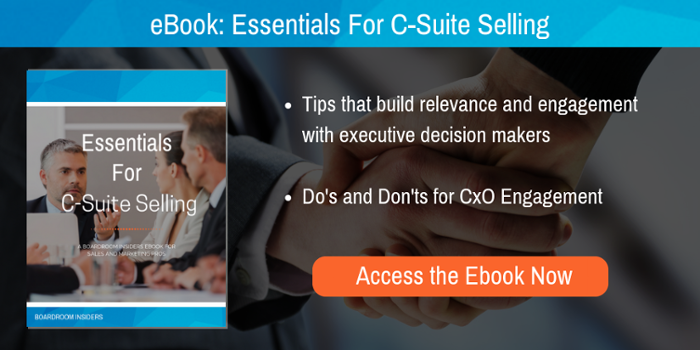
In a recent conversation with our sales team, I was asked to write about how our executive profiles can support Sales Development Representatives (SDRs), the people on the front lines of selling.
“Wait a minute,” I said. “I thought SDRs were the most junior, fresh-out-of-school people in sales. Surely companies don’t have them calling into the C-suite.”
“But they do,” said one colleague.
Whoa. That got my attention. I couldn’t imagine being accountable for having conversations with CXOs when I was 25. I would have been shaking in my shoes! Most people don’t have the business acumen and confidence to pull off a conversation with a CXO that early in their careers.

Now, I’m not going to argue why the most junior people on the team should not be calling CXOs. I have to assume that our customers and prospects know a lot more than we do about how to carve up the enterprise sales process to maximize sales success—they wouldn’t be doing it if it didn’t work.
So I decided to do a little research on SDRs.
First I found this, written by Glen Lipka, Head of Magic (PM/UX) at Engagio:
“Sales Development Representatives (sometimes called Business Development Reps) are typically junior employees, often right out of college, who qualify accounts against a number of criteria such as budget, buying authority and company fit. The SDR job is to make sure that senior account executives don’t waste their time on poor opportunities. The ability to focus the attention on achievable deals is the life-blood of the sales person. The SDR is supposed filter out all of the bad deals.”
So SDRs are the most junior people on the team. And their main job is to qualify leads and opportunities. Here are some of the things expected of an average SDR, which were pulled from real job SaaS company job listings:
- Prospect into a target account list ranging from the Fortune 500 to medium-sized organizations.
- Self-source own pipeline of Enterprise customers and process inbound leads
- Make 50-60 prospecting calls a day
- Form relationships with Managers, Directors, and C-Level executives.
- Email and network with potential customers
- Ask thorough and pointed questions, guiding potential clients through needs analysis and discovery sessions to qualify the lead and drive new opportunities
- Hit monthly sales metrics
These job listings were typically targeting people with between 6 months and one year of experience.
My take is that a lot is being asked of people with very little experience. But, having hired a few salespeople myself, I know that if you hire smart, ambitious people and give them the right mentoring, training and tools, they can deliver great results.

We want to be part of the solution—and the success of SDRs. So, given that our experience and focus at Boardroom Insiders is on C-Suite selling, here are five tips for SDRs charged with prospecting in the C-Suite:
Tip 1: Commit to a different approach for CXO prospects.
C-Suite prospecting should not be lumped in with other kinds of prospecting. It can’t be automated or standardized. You can’t use a one-size-fits-all message or approach. Always remember: a CXO is a segment of ONE. And that first touch—and here is where the SDR comes in--can make or break an opportunity.
Tip 2: Do your homework on each individual CXO--before you contact them.
If you want to cut through the “noise” in a CXO’s inbox or get past their gatekeeper, your message has to be relevant--and it has to be about them, not you. To achieve this, you have to know what they care about, so invest some time in learning something about them. Now, it is likely the CXO will just forward your well-crafted email on to one of his lieutenants to handle the conversation. But you still better know what the top brass cares about—the company’s strategy and initiatives—because no matter who you talk to, they will be marching to that same drum beat.
Tip 3: Build your first communication around one compelling “hook.” Keep it short and sweet.
In the course of your research (see Tip 2, above), look for one (yes, just one) “hook” that shows that you know something about them and that they can benefit from the product or service you sell. It is always best to find something they said and quote it back to them. Few people can ignore you when you are using their own words. Be brief—the goal is to capture their interest and get them to ask for more.
Tip 4: Be politely persistent and continue to add value.
It is rare to get a reply from a CXO on your first try. Don’t give up. Look for ways to deliver more value while showing you have done your homework and understand their business. For example, send them a piece of content that you know is relevant, based on something they have said. Continue to keep up to date on what they are saying in interviews and on earnings calls; and look for more hooks that connect the dots back to your products and services being a good fit.
Tip 5: Bring in the big guns—and brief them appropriately.
Most SDRs are probably not experienced enough to pull off a business conversation with a CXO. And even if you are, CXOs typically want to speak with someone in a more senior role. In the spirit of not treating CXOs like any other lead (See Tip 1, above), keep your managers apprised of any CXO conversations you are having and share the homework you have done on these prospects so they can seamlessly pick up where you left off.
Is There a Promotion in Your Future?
I can guarantee that SDRs who consistently follow these five tips will make a good impression—not only with CXO prospects, but with their own managers.
We Take the Fear Out of C-Suite Selling
Boardroom Insiders helps SDRs feel more confident calling into the C-Suite. We also save SDRs—and sales teams—valuable research time by providing instant insight on CXO decision makers in the Fortune 500 and beyond. Our executive profiles include information on executive decision makers and their business initiatives—often in their own words. We also offer “how to” ebooks, articles and videos on the topic of C-Suite selling and engagement. For more information, view our sample profiles or visit our Resources Library.








Share Your Thoughts